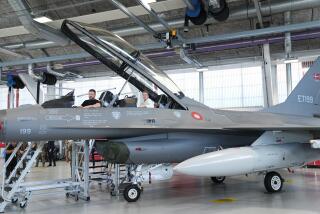American Warplanes Occupy Old-Fly Zone
Some of the world’s most sophisticated and deadly weapons have been launched against Iraq by jet-fighters and bombers that are decades old, in many cases far older than the pilots who fly them.
With few exceptions, such as robotic spy planes, the aircraft in the U.S. arsenal were developed during the Cold War era of the Truman, Eisenhower and Nixon administrations. Even the newest, including the F-117 stealth fighter that made the first strikes Thursday, flew in the Persian Gulf War 12 years ago.
The oldest in the fleet and the workhorse of the Iraqi bombing campaign, the eight- engine B-52 bomber, was put on the drawing board toward the end of World War II and first flew during the Korean War. The last B-52 built rolled out of Boeing Co.’s Renton, Wash., factory 41 years ago.
Some defense industry analysts say the fleet is so old that there are planes in danger of falling apart. But the Pentagon insists that its fighters and bombers -- with an average age of 22 years -- are more capable than ever, having been continually upgraded with new electronics, engines and weapons.
The Pentagon spends about $2 billion a year upgrading its air forces. Companies spend billions of dollars more annually developing new electronics for military aircraft, work that has sustained the defense industry in Southern California.
Once focused on aircraft manufacturing, defense companies such as Raytheon Co. in El Segundo and Boeing’s operations in Orange County have shifted to researching and developing new and more advanced components for aging planes. Hundreds of engineers at Northrop Grumman Corp.’s El Segundo unit and Lockheed Martin Corp.’s legendary Skunk Works in Palmdale are working on upgrades to B-2 Spirit stealth bombers and F-117 fighters. Modifications and upgrades are tested at Edwards Air Force Base near Lancaster and at the Naval Air Warfare Center in China Lake, Calif.
Many analysts say that fitting old craft with new gear more than does the trick.
“The airframe for these planes were built 15 to 20 years ago, but their guts have been consistently rejuvenated,” said Richard Aboulafia, an aerospace analyst for Fairfax, Va.-based Teal Group Corp. “They’re infinitely more effective than they ever were.”
Dissenters, including some Pentagon officials in private conversations, say they are increasingly uneasy about the aging fleet, particularly because of the potential for the aircraft to fall apart from structural fatigue and corrosion, consequences of old age that have plagued the country’s aerial firefighting fleet.
“It may seem like the most powerful air force in the world, but plane for plane it’s more like a collection of museum pieces,” said Loren Thompson, a defense policy analyst for the Lexington Institute in Arlington, Va. “The upgraded F-15s have all sorts of new things
Thompson recalled a story an Air Force general told him a few years ago: The general, in charge of patrolling Iraq’s northern “no-fly” zone, was flying an F-15C when the cockpit electronics suddenly went blank. After the plane barely made it back to base, the maintenance staff discovered that the wiring insulation had turned into powder. The general said he was stunned when he later discovered he had flown the same plane two decades earlier.
“What worries the Air Force is that we haven’t faced serious challenges, so we have not had the urgency to buy new aircraft,” Thompson said, noting that the next-generation fighter jet, the F-22, has been in development for more than a decade yet isn’t expected to be operational until 2006. “Meanwhile, structural fatigue and corrosion [are] becoming a major issue.”
Certainly, with an aging fleet comes the headache of maintaining it with a shrinking inventory of parts and supplies that are no longer made, difficult to find or costly to remake. The problem is so acute that it’s common practice at Air Force and Navy maintenance facilities to cannibalize planes, according to government documents.
Using Aircraft for Parts
In a 2001 report, the General Accounting Office noted that from 1995 through 2000, Air Force and Navy repair crews spent 5 million hours -- the equivalent of 500 maintenance personnel working full time for five years -- taking 850,000 parts from some aircraft to replace defective or damaged equipment in others.
The report, which cautioned that the armed services probably were grossly underreporting incidents of cannibalization, noted that in one case, 136 parts from a single C-5 transport plane were used to repair other aircraft.
The shortage of parts reflects changes in priorities since the end of the Cold War, analysts said. And that is reflected in how the Pentaon spends its budget.
“During the Cold War, when we had powerful adversaries, we were focused on developing newer, better and faster weapons,” said Christopher Michel, a former Navy P-3 Orion mission commander who now runs Military.com, a Web site for military personnel.
Now, he said, “we’re playing on a different dimension. It’s more about intelligence, special operations and computer networking.”
The nature of warfare has changed from a singular focus on massive, devastating nuclear attacks to smaller-scale skirmishes against adversaries that are not as well equipped as the United States or as well defined.
Pentagon strategists have focused on developing weapons with more accuracy, radar with far greater range and improved communication systems that allow pilots to communicate directly with ground forces.
The new precision weapons have themselves changed the dynamics of aerial bombing, analysts said.
A single satellite-guided joint direct attack munition can fall within a yard of target coordinates with enough ordnance to destroy a factory -- a stark contrast from World War II when it sometimes took hundreds of missions to destroy a single building.
About 7% of the bombs dropped during Operation Desert Storm in 1991 were precision-guided; analysts believe that at least 80% of the bombs in the current air campaign against Iraq are likely to be guided by satellite or laser.
The aircraft have become a delivery system, Michel said. “They’re not called fighters or bombers anymore. They’re called weapon platforms.”
The changing role is best reflected in the evolution of the B-52, which was designed to drop nuclear bombs deep inside the Soviet Union.
In some ways, the B-52 became the primary U.S. bomber by default. Several replacements were developed through the years, but none could match its reliability and versatility. Others fell victim to shifting politics.
The supersonic B-58 Hustler and B-70 Valkyrie developed in the late 1950s and early 1960s eventually were dropped. The B-1B Lancer bomber continues to struggle for respect, and the Pentagon has been scaling back the fleet.
The B-2, the newest bomber, was supposed to be the ultimate replacement, but the military decided to build only 21 planes as the Cold War ended.
The Long-Range Plan
With no new bomber on the drawing board, Pentagon planners are hoping to operate the B-52 for 40 more years. The long-range plan doesn’t call for design work to start on a new bomber until 2013. Nobody can say how many of the 85 B-52s in the fleet -- down from 744 in the plane’s heyday -- will survive until then. But modifications have become a common part of the fleet’s life.
The most recent variant of the B-52, built between 1960 and 1962, has undergone more than 30 major modifications, including having its wings and fuselage reinforced.
The World War II-era tail gunner position has been removed and new global positioning systems have been installed, although some B-52s still have vacuum tubes behind the electronic bays. Modernized versions have computers, though they are only as powerful as the original personal computers in the early 1980s.
Other aircraft in the Iraqi air campaign are younger but still derive much of their technology from the 1960s and 1970s:
* The twin-engine, supersonic F-14 Tomcat, long the Navy’s mainstay and popularized by the movie “Top Gun,” began development in 1966 and took its first flight in 1970. The Navy wants to retire the plane by 2008, nearly four decades after it began taking off from aircraft carriers.
* The F/A-18 Hornet supplements the F-14 in the Navy’s air fleet. The F/A-18 was developed in the early 1970s and took its first flight in 1978. Several variants were developed, including the F/A-18 C/D, which began flying in 1987.
* The F/A-18 Super Hornet, a larger version with 25% more wingspan, began operational flights last year and saw its first combat action in November, when it struck Iraqi targets in the “no-fly” zone.
* The F-15 Eagle, the Air Force’s air-superiority fighter jet, went on the drawing board in 1966 and took off for the first time in 1972. Five variations have been made, with the most recent -- the F-15E -- taking its first flight in 1986.
* The F-16 Fighting Falcon, a single-engine jet combat aircraft, was designed in 1971 and flew in 1978. Five versions have been built, the most recent getting airborne in 1984.
* The F-117A Nighthawk, the first stealth fighter designed to evade radar, was in development in the early 1970s and in the air in 1981. The last of the 36 F-117s was built in 1990.
* The B-1A, a supersonic bomber designed to fly at low altitude and penetrate Soviet air defenses, began development in 1963 and first flew in 1974. An improved variant, the B-1B Lancer, is in use over Iraq and took its first flight in 1984.
In the end, in terms of what’s in the air, the current war won’t be much different from the last.
“What you’ve got are extremely upgraded versions of what we saw last time,” Aboulafia said, “except they’ll just be 12 years older.”
More to Read
Inside the business of entertainment
The Wide Shot brings you news, analysis and insights on everything from streaming wars to production — and what it all means for the future.
You may occasionally receive promotional content from the Los Angeles Times.










